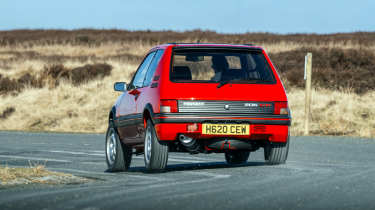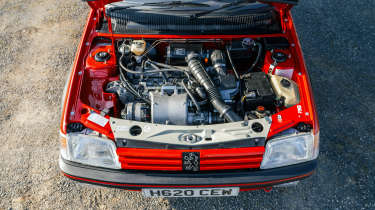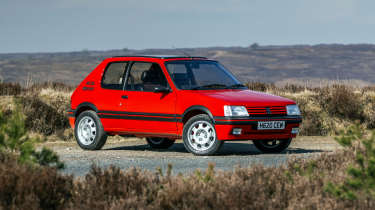Used Peugeot 205 GTI (1985 - 1995) review – the ultimate retro 1980s hot hatch?
With the 205 GTI, Peugeot set the blueprint for what we look for in a small fun hot hatch. Willing, chuckable, often a little too exciting for the driver’s own good
Debate runs rife as to the origins of the hot hatch. The Mini Cooper S dates all the way back to the 1960s, while Abarth were turning out mad little hatters as early as 1971, in the form of the A112. There’s a whole slew of machinery – Alfasud Ti, Simca 1100 Ti, Renault 5 Gordini – before the first car to go so mainstream as to take widespread credit as the first hot hatch, the Golf GTI, arrived in 1975.
For evo, though? In with a shout of being the first hot hatch in the form that we came to know, adore and now sorely miss, is the Peugeot 205 GTI. Certainly, it was a defining car of the increasingly performance car-crazed decade that was the 1980s. So performance car-crazed that a magazine by the imaginative name of Performance Car was launched to offer insight on them all. The GTI was a clear shoo-in for our recent evo Eras: 1980s test, reflecting on the cars that graced the first pages of our predecessor title.
Peugeot 205 GTI history
Launched in 1984, almost a decade on from the fabulous Golf of the same badge, the 205 GTI, in 1.6-litre form, the badge boastful that yes, this was a car that featured fuel injection. Just 105bhp doesn’t sound like much but the fact it was only charged with shunting 900kg up the road meant it was a brisk device, especially in the mid-1980s.
More reviews
The 0-62mph sprint took a spritely 8.7sec on the way to a dizzying 116mph – that really is dizzying in a car as diminutive and minimalist as the GTI. It wasn’t long though before the stroked-out 1.9 with 130bhp blustered onto the scene, dropping the 0-62mph time to 7.8sec and increasing the top speed to 127mph.
Subsequent improvements and adjustments were made – the 1.6 gained a bit of power while catalytic converters went on to stifle the 1.9 somewhat. Other driver focused versions of the 205 appeared too, most notably the stripped out Rallye with just 75bhp from its 1.4-litre engine but only 795kg to lug along.
It’s the 1.9 GTI that’s remembered most famously as being the hot rod of the family but connoisseurs know the 1.6 as the more responsive, eager engine to whip up and down the tacho with the throttle. Whichever GTI you get, you’re in for a riot (and a challenge) as it’s not of a hot hatch type that would follow years later, led by excess power and a wandering front end. Rather it was a lythe, mobile device, sometimes too eager to rotate around the driver should they lose confidence in their throttle application at pace.
Such was the volume of incidents involving GTIs and affordable performance cars in general, that skyrocketing insurance costs all but snuffed out 205 GTI sales into the 1990s. The 1.6 was phased out in 1992, with the 1.9 given a stay of execution by fitment of a catalytic converter, until its discontinuation in 1995.
The shots of adrenaline into the brains of those who came to know the 205 GTI years ago, are what burned it so indelibly in hot hatch and performance car lore and why it enjoys the stature and status it does over 40 years on.
What we said:
‘Details betray the Pug’s age – bolts and fixings visible through the grille, the rudimentary cradle for the spare wheel under the tail. The design inside is pleasing but some of the plastics clearly rather low-rent, and the seating position is a little high, the wheel a little low. Yet once underway none of this matters because it takes only a few miles for the 205 to get completely under your skin.
‘The gearstick is long and shaped like the business end of a golf club, the throw longer than that of any modern hatch but actually fingertip-light at speed. The steering (power-assisted on this car) is hyper-alert, with little slack in the chassis’ responses.
But the ride is again supple, there’s lean into corners and you can just sense it start to pick up the inside rear wheel. It doesn’t take much imagination to know that if you overcooked it and then bailed out it could get interesting. ‘Very much a dry weather car,’ is Barker’s view.
‘The steering’s power assistance is subtle, but according to Meaden it makes it a much better car. ‘The ones without power steering are horrible,’ he grimaces. In the ’90s he co-owned a GTI with Performance Car/evo regular Roger Green. ‘It’s fun getting back into one of these again. It all came back – the tall, slightly wobbly gearlever and the resistant, slightly notchy feel; the slightly spluttery-sounding idle, and the little bit of low-speed shunt – we forget it was still early days for mass-produced fuel injection.’
‘Never driven one before,’ says Yousuf. ‘Everything about it feels light and crisp and positive. You don’t think about the controls too much, you just get on with the job of thrashing it, and it seems to love that. You’re not going quickly but it feels like you are. Like the MR2 it’s quite soft, but you use the weight transfer to help the flow. It’s a lot of fun.’
‘The 205 has that terrier-like quality that infects all the best hatches and would see it snapping at the heels of supposedly sporting coupes and roadsters. Back in the ’80s this would have been an MGB or TR7 driver’s worst nightmare.’ – Peter Tomalin, evo lifer and contributor, who conducted the evo Eras: 1980s test, pitting a 1.9 205 GTI against other titans of the decade.
Peugeot 205 GTI buying guide
Those who are familiar with most performance cars of the 1980s know that for their simplicity, they are mechanically sturdy (generally speaking). They also know that almost the opposite is the case when it comes to their chassis and bodywork, though the 205 GTI, with its partial galvanisation, is at least somewhat harder-of-jaw. Nonetheless, the boot floor, brake pipes, inner-wings, footwells, doors, roof and under the seats warrant close inspection for tinworm. Look around all the window seals (and the sunroof if applicable) for leaks, too.
Many years have passed and the rate of attrition for ratty, poorly-maintained 205 GTIs that arguably peaked in the 2000s, has slowed to a crawl. The cars that remain tend to be well cared-for – straight and rust free or often, dutifully and diligently repaired.
As we found in our test, the engines of the GTI with their early fuel injection can come across as lumpy and choppy, especially by comparison to the almost imperceptible, sowing machine-like operation of most modern petrol engines. Most of the time, this is natural; however, if it’s really choppy or smokey, some tinkering or a deeper dive into the engine may be required for valve stem seal replacement.
Be sure to test drive your chosen example, get a good feel of the steering and gear shift and listen out for untoward clunks that could be indicative of component wear that needs attention.
Such is the 205 GTI's cult classic status that preparers and restorers and restomodders have long been in the game of perfecting the GTI. Tolman for instance will prepare immaculate cars with 193bhp 1.9-litre engines, among other choice upgrades. If originality is your desire, none do it better than AutoRARA, who prepared the simply stunning example featured in our test.
Peugeot 205 GTI values and specs
Values are a huge point of conversation around 205 GTIs. There’s a reason Tolman saw a business case in £125k restomods. Nonetheless, 205 GTIs are still mostly within reach. A passable 1.9, with miles and in need of a bit of TLC will set you back in the region of £8-9k, while an absolutely immaculate, low-miles car will get up over the £30k mark. The 1.6 ranges from £6k to £26k respectively.
What could you have instead of a 205 GTI? Well very much in the image of the 205, was the 106 Rallye and GTI of the 1990s and early 2000s. Lightweight, foursquare of stance and mobile of tail, it’s the spirit of the 205 faithfully transposed onto (slightly) more modern bones and for less cash too.
The original Golf GTI as well as the Mk2 aren’t considered to be quite so up for a bit of rough and tumble as the old Pug but are still worthy, if pricey, alternatives. Just don’t go down the 206 GTI route, we beg of you…
Peugeot 205 GTI specs
| Engine | In-line 4-cyl, 1905cc |
|---|---|
| Max power | 130bhp @ 6000rpm |
| Max torque | 121lb ft @ 4750rpm |
| Weight | 910kg (145bhp/ton) |
| 0-60 | 7.6sec |
| Top speed | 125mph+ |
| Price new | £9930 (c£27k today) |
| Value now | £6k-£35k |









